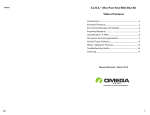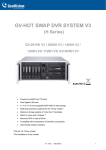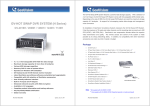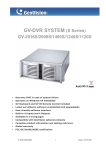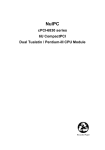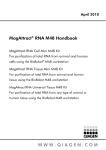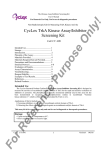Download E.Z.N.A.®miRNA Kit - Omega Bio-Tek
Transcript
E.Z.N.A.® miRNA Kit R7034-00 R7034-01 R7034-02 5 preps 50 preps 200 preps August 2011 E.Z.N.A.® Micro RNA Kit Table of Contents Introduction and Overview.......................................................2 Kit Contents/Storage and Stability..........................................3 Preparing Reagents.......................................................................4 Before Beginning...........................................................................5 Tissue Homogenization Protocols..........................................6 Micro RNA from Cells/Tissue.....................................................7 Large RNA from the HiBind® RNA Mini Column............11 DNase I Digestion Protocol.......................................................13 Troubleshooting Guide.............................................................16 Ordering....................................................................................17 Manual Revision: August 2011 Innovations in nucleic acid isolation 1 Introduction and Overview Introduction E.Z.N.A.® Micro RNA Kit provides a rapid and easy method for the isolation of up to 50 μg of small and large-size RNA from cultured eukaryotic cells or bacteria, or from animal, plant, or fungal tissues. Single or multiple samples can be simultaneously processed in less than 30 minutes. Typically, up to 1 x 106 eukaryotic cells, 1 x 109 bacterial cells, 50 mg animal tissue, or 100 mg plant tissue can be used in a single experiment. RNA purified using the E.Z.N.A.® Micro RNA method is ready for applications such as RTPCR*, Northern blotting, and nuclease protection assays. Overview The E.Z.N.A.® Micro RNA Kit combines the reversible binding properties of HiBind® matrix, a new silica-based material, with the highly efficient lysis ability of RNA-Solv® to extract micro and large (>200 nt) RNA from a wide variety of starting materials. A specially formulated high-salt buffer system allows more than 100 μg of RNA to bind to the matrix. Cells or tissues are first homogenized with RNA-Solv® Reagent that inactivates RNases. After the addition of chloroform, the homogenate is separated into aqueous and organic phases. The aqueous phase, which contains the RNA, is adjusted with ethanol and loaded onto a HiBind® RNA Mini Column that binds the large RNA. The miRNA is filtered through the column and collected. Large RNA subsequently can be eluted from the HiBind® RNA Mini Column with DEPC Water. The miRNA filtrate is loaded onto a HiBind® Micro RNA Column so that proteins and other contaminates can be removed. Purified miRNA is eluted with DEPC Water. New in this Edition: This manual has been edited for content and redesigned to enhance user readability. 2 Kit Contents Product Purifications HiBind® Micro RNA Column R7034-00 R7034-01 R7034-02 5 preps 50 preps 200 preps 5 50 200 HiBind® RNA Mini Column 5 50 200 2 mL Collection Tubes 10 100 400 RNA-Solv® Reagent 5 mL 2 x 28 mL 8 x 25 mL RNA Wash Buffer l 5 mL 50 mL 200 mL RNA Wash Buffer II 5 mL 2 x 12 mL 2 x 50 mL DEPC Water 1 mL 10 mL 40 mL User Manual P P P Note: RNA-Solv® Reagent contains guanidine thiocyanate and phenol, handle this reagent with extra care. Safety and risk phase: R20-24/25-32-34, S13-26-36/37/39-45 Storage and Stability All components in E.Z.N.A.® Micro RNA Kits, except the RNA-Solv® Reagent, should be stored between 22-25°C. RNA-Solv® Reagent should be store between 2-8°C for long term storage. 3 Preparing Reagents Dilute RNA Wash Buffer II with 100% ethanol as follows and store at room temperature: 4 Kit 100% Ethanol To Be Added R7034-00 20 mL R7034-01 48 mL per bottle R7034-02 200 mL per bottle Important Notes Please take a few minutes to read this booklet in its entirety to become familiar with the procedures. Prepare all materials required before starting to minimize RNA degradation. • Whenever working with RNA, always wear gloves to minimize RNase contamination. Use only clean RNase-free disposable plastic pipette tips when using the supplied reagents. • Equilibrate samples and RNA-Solv® Reagent to room temperature before beginning this protocol. All steps should be carried out at room temperature unless otherwise noted. Work quickly, but carefully. • Prepare all materials required before starting the procedure to minimize RNA degradation. • Carefully apply the sample or solution to the center of the HiBind® RNA Mini and the HiBind® Micro RNA Columns. Avoid touching the membrane with pipet tips. Starting Materials Although the binding capacity for the HiBind® RNA Mini and the HiBind® Micro RNA Columns are approximately 100 μg, the maximum amount of starting material depends on the type of tissue being processed and its corresponding RNA content. It is essential to begin with the correct amount of tissue to get optimal RNA yield and purity with the E.Z.N.A.® Micro RNA Kit. For the first time user, we recommend to use less than 30 mg of tissue per sample. Depending on the yield and purity obtained, it may be possible to increase the starting material up to 100 mg (maximum amount). 5 Tissue Homogenization Protocols Efficient sample disruption and homogenization is essential for successful RNA isolation. Cell wall and plasma membrane disruption is necessary for the release of RNA from the sample and homogenization is necessary to reduce the viscosity of the lysates. Homogenization shears genomic DNA and other high-molecular-weight cell components creating a homogenous lysate. Incomplete homogenization can cause the HiBind® RNA Mini Column to clog resulting in low or no yield. Liquid Nitrogen Method - Recommended • Wear appropriate gloves and take great care when working with liquid nitrogen. • Excise tissue and promptly freeze in a small volume of liquid nitrogen. • Grind tissue with a ceramic mortar and pestle under approximately 10 mL liquid nitrogen. • Pour the suspension into a pre-cooled 15 mL polypropylene tube. Note: Unless the tube is pre-cooled in liquid nitrogen, the suspension will boil vigorously and may cause loss of tissue. • Once the liquid nitrogen has completely evaporated, continue to Step 1 of the “miRNA from Cells and Tissue Protocol” on Page 7. Rotor-stator Homogenizers Rotor-stator homogenizers effectively homogenize most tissues. The process usually takes less than a minute depending on the tissue. Many rotor-stator homogenizers operate with differently sized probes or generators that allow processing of small volumes in microcentrifuge tubes. Such homogenizers are available from: • • • Tekmar Inc., Cincinnati, OH (Tissuemizers®) BIOSPEC Products, Bartlesville, OK (Tissue-Tearor™) Craven Laboratories, Austin, TX. Syringe Method High-molecular-weight DNA is responsible for the viscosity of cell lysates and can be shredded by passing the sample through a 19-21 gauge needle several times. 6 E.Z.N.A. Micro RNA Kit Protocol E.Z.N.A.® Micro RNA Kit Protocol - miRNA from Cells and Tissue Materials and Reagents to be Supplied by User: • • • • • • 96-100% Ethanol Chloroform, ACS Grade RNase-free filter pipette tips 1.5 or 2 mL nuclease-free microcentrifuge tubes Microcentrifuge capable of 12,000 x g and 4°C Ice Bucket Before Starting: • • Prepare RNA Wash Buffer II according to the instructions in the “Preparing Reagents” section on Page 4. Prepare an Ice Bucket 1. Lyse cells or tissue with 1 mL RNA-Solv® Reagent. Note: 1 mL of RNA-Solv® Reagent is sufficient for the lysis of 1 x 107 cultured cells, 3050 mg animal tissue, or 50-100 mg plant tissue. A. For culture cells grown in monolayer (fibroblasts, endothelial cells, etc.) lyse the cells directly in the culture vessel as follows: 1. Aspirate and discard the culture medium. 2. Add 1 mL RNA-Solv® Reagent directly to the cells making sure to cover the entire surface of the vessel to ensure complete lysis. 3. Transfer the lysate to a clean 2 mL microcentrifuge tube (not provided). 4. Proceed to Step 2. Note: This method is preferable to trypsinization followed by washing because it minimizes RNA degradation by nuclease contamination. B. For cells grown in suspension cultures: 1. Pellet cells at no greater than 1,500 rpm (400 x g) for 5 minutes. 2. Discard the supernatant. 3. Add 1 mL RNA-Solv® Reagent. 4. Vortex or pipette up and down to lyse the cells. 5. Transfer the lysate to a clean 2 mL microcentrifuge tube (not provided). 6. Proceed to Step 2. 7 E.Z.N.A. Micro RNA Kit Protocol C. For tissue samples, determine the size of the samples and homogenize by using one of the methods discussed on Page 6. Unless using liquid nitrogen, homogenize samples directly in 1 mL RNA-Solv® Reagent and proceed to Step 2. 2. Incubate at room temperature for 3 minutes. 3. Add 0.2 mL chloroform per 1 mL RNA-Solv Reagent. Cap the tubes securely and vortex vigorously for 15 seconds. 4. Incubate on ice for 10 minutes. 5. Centrifuge at 12,000 x g at 4°C for 15 minutes. Note: The mixture separates into a lower phenol-chloroform phase, an inter phase, and an upper aqueous phase. RNA remains entirely in the upper aqueous phase. 6. Transfer no more than 80% of the upper aqueous phase to a new 2 mL microcentrifuge tube (not provided). 7. Add 0.33 volumes of ethanol. Vortex to mix thoroughly. Note: A precipitate may form after the addition of ethanol. Removal of Large RNA (>200 nt) 8. Insert a HiBind® RNA Mini Column into a 2 mL Collection Tube provided with this kit. 9. Transfer 700 μL of the mixture from Step 7 to the HiBind® RNA Mini Column. 10. Centrifuge at 10,000 x g at room temperature for 1 minute. 11. Transfer the filtrate into a new 2 mL microcentrifuge tube (not provided) for small RNA isolation. 8 E.Z.N.A. Micro RNA Kit Protocol 12. Repeat Steps 9-11 until all the remaining sample has been transferred to the column. Note: Each transfer of the filtrate (Step 11) should be to the same 2 mL microcentrifuge tube for one combined filtrate sample. Note: To isolate large-size total RNA (>200 nt) continue to the “Large RNA from HiBind® RNA Mini Column Protocol” in the next section on Page 11. For purification of miRNA, continue to Step 13 below. If both miRNA and large RNA (>200 nt) are required, both protocols need to be completed in a single day. Hold the HiBind® RNA Mini Column at 4°C until the miRNA Purification protocol below has been completed. Purification of Micro RNA 13. Measure the volume of the filtrate collected at the end of Step 12. 14. Add 0.65 volumes of ethanol to the filtrate. Vortex to mix thoroughly. 15. Insert a HiBind® Micro RNA Column into a clean 2 mL Collection Tube provided with this kit. 16. Transfer the mixture from Step 14 to the HiBind® Micro RNA Column. 17. Centrifuge at 10,000 x g for 1 minute. Discard the filtrate and reuse the Collection Tube. 18. Repeat Steps 16-17 until all the remaining sample has been transferred to the HiBind® Micro RNA Column. 19. Add 500 μL RNA Wash Buffer II to the HiBind® Micro RNA Column. Note: RNA Wash Buffer II must be diluted with ethanol before use. Please see Page 4 for instructions. 20. Centrifuge at 10,000 x g for 1 minute. Discard the liquid and reuse the Collection Tube. 9 E.Z.N.A. Micro RNA Kit Protocol 21. Repeat Steps 19-20 for a second RNA Wash Buffer II wash step. 22. Centrifuge at full speed ( ≥12,000 x g) for 2 minutes to completely dry the HiBind® matrix. Note: It is important to dry the HiBind® Micro RNA matrix before elution. Residual ethanol may interfere with downstream applications. 23. Transfer the HiBind® Micro RNA Column to a clean 1.5 or 2.0 mL microcentrifuge tube (not provided). 24. Add 15-30 μL DEPC Water. Note: Make sure to add water directly onto the HiBind® Micro RNA Column matrix. 25. Incubate at room temperature for 2 minutes. 26. Centrifuge at full speed for 1 minute. Store eluted RNA at -70°C. Note: Any combination of the following steps can be used to help increase RNA yield. • Preheat the DEPC Water to 70°C before elution. • Increase the incubation time to 5 minutes. • Increase the elution volume. • Repeat the elution step with fresh DEPC Water (this may increase the yield, but decrease the concentration). • Repeat the elution step using the eluate from the first elution (this may increase yield while maintaining elution volume). 10 E.Z.N.A. Large RNA Protocol E.Z.N.A.® Micro RNA Kit Protocol - Large RNA from HiBind® RNA Mini Column This protocol is designed for isolation of RNA >200 nt. If performing DNase I digestion, use the DNase I Digestion Protocol found on Page 13. Materials and Reagents to be Supplied by User: • • • RNase-free filter pipette tips 1.5 or 2 mL nuclease-free microcentrifuge tubes Microcentrifuge capable of 12,000 x g Before Starting: • Prepare RNA Wash Buffer II according to the instructions in the “Preparing Reagents” section on Page 4. Important Notes: • All steps must be carried out at room temperature. Work quickly, but carefully. 1. Complete Steps 1-12 of the Micro RNA Protocol protocol 2. Transfer the HiBind® RNA Mini Column into a 2 mL Collection Tube (provided). 3. Add 500 μL RNA Wash Buffer I to the HiBind® RNA Mini Column. 4. Incubate at room temperature for 5 minutes. 5. Centrifuge at 10,000 x g for 1 minute. 6. Discard the filtrate and reuse the Collection Tube. 11 E.Z.N.A. Large RNA Protocol 7. Add 500 μL RNA Wash Buffer II to the HiBind® RNA Mini Column. Note: RNA Wash Buffer II must be diluted with ethanol before use. Please see Page 4 for instructions. 8. Centrifuge at 10,000 x g for 1 minute. 9. Discard the filtrate and reuse the Collection Tube. 10. Repeat Steps 7-9 for a second RNA Wash Buffer II wash step. 11. Centrifuge at full speed ( ≥12,000 x g) for 2 minutes to completely dry the HiBind® RNA Mini Column. Note: It is important to dry the HiBind® RNA Mini Column matrix before elution. Residual ethanol may interfere with downstream applications. 12. Transfer the HiBind® RNA Mini Column to a clean 1.5 or 2 mL microcentrifuge tube (not supplied). 13. Add 40-70 μL of DEPC Water. Note: Make sure to add water directly onto the HiBind® RNA Mini Column matrix. 14. Incubate at room temperature for 2 minutes. 15. Centrifuge at full speed for 1 minute. Store eluted RNA at -70°C. Note: Any combination of the following steps can be used to help increase RNA yield. • Preheat the DEPC Water to 70°C before adding to the column. • Increase the incubation time to 5 minutes. • Increase the elution volume. • Repeat the elution step with fresh DEPC Water (this may increase the yield, but decrease the concentration). • Repeat the elution step using the eluate from the first elution (this may increase yield while maintaining elution volume). 12 E.Z.N.A.® DNase I Digestion Protocol E.Z.N.A.® Micro RNA Kit - DNase I Digestion Protocol Since the HiBind® matrix of the RNA Column eliminates most DNA, DNase I digestion is not necessary for most downstream applications. However, certain sensitive RNA applications may require further DNA removal. (See DNase I Digestion Set, Cat# E1091 for more information). After completing Steps 1-15 of the Animal Cell Protocol (Pages 11-15), Steps 1-13 of the Animal Tissue Protocol (Pages 17-19), or Steps 1-6 of the Vacuum/Spin Protocol (Pages 2122), proceed with the following protocol. User Supplied Material: • DNase I Digestion Set (Cat# E1091) 1. For each HiBind® RNA Mini Column, prepare the DNase I stock solution as follows: Buffer Volume per Prep E.Z.N.A.® DNase I Digestion Buffer 73.5 μL RNase-free DNase I (20 Kunitz/µL) 1.5 μL Total Volume 75 μL Important Notes: 2. • DNase I is very sensitive and prone to physical denaturing. Do not vortex the DNase I mixture. Mix gently by inverting the tube. • Freshly prepare DNase I stock solution right before RNA isolation. • Standard DNase buffers are not compatible with on-membrane DNase I digestion. Using other buffers may affect the binding of RNA to the HiBind® matrix and may reduce RNA yields and purity. • All steps must be carried out at room temperature. Work quickly, but carefully. Insert the HiBind® RNA Mini Column containing the sample into a 2 mL Collection Tube provided with this kit. 13 E.Z.N.A.® DNase I Digestion Protocol 3. Add 250 µL RNA Wash Buffer I to the HiBind® RNA Mini Column. 4. Centrifuge at 10,000 x g for 1 minute. 5. Discard the filtrate and reuse the Collection Tube. 6. Add 75 μL DNase I digestion mixture directly onto the surface of the membrane of the HiBind® RNA Mini Column. Note: Pipet the DNase I directly onto the membrane. DNA digestion will not be complete if some of the mixture is retained on the wall of the HiBind® RNA Mini Column. 7. Incubate at room temperature for 15 minutes. 8. Add 250 μL RNA Wash Buffer I to the HiBind® RNA Mini Column. 9. Incubate at room temperature for 2 minutes. 10. Centrifuge at 10,000 x g for 1 minute. 11. Discard the filtrate and reuse the Collection Tube. 12. Add 500 μL RNA Wash Buffer II. 13. Centrifuge at 10,000 x g for 1 minute. 14. Discard the filtrate and reuse the Collection Tube. Note: RNA Wash Buffer II must be diluted with ethanol before use. Please see Page 5 for instructions. 15. Repeat Steps 12-14 for a second RNA Wash Buffer II wash step. 14 E.Z.N.A.® DNase I Digestion Protocol 16. Centrifuge at full speed ( ≥12,000 x g) for 2 minutes to completely dry the HiBind® RNA Mini Column. Note: It is important to dry the HiBind® RNA Mini Column matrix before elution. Residual ethanol may interfere with downstream applications. 17. Place the column in a clean 1.5 or 2.0 mL microcentrifuge tube (not supplied). 18. Add 40-70 μL DEPC Water. Note: Make sure to add water directly onto the HiBind® RNA Mini Column matrix. 19. Incubate at room temperature for 2 minutes. 20. Centrifuge at full speed for 1 minute and store eluted RNA at -70°C. Note: Any combination of the following steps can be used to help increase RNA yield. • • • • • Preheat the DEPC Water to 70°C before adding to the column. Increase the incubation time to 5 minutes. Increase the elution volume. Repeat the elution step with fresh DEPC Water (this may increase the yield, but decrease the concentration). Repeat the elution step using the eluate from the first elution (this may increase yield while maintaining elution volume). 15 Troubleshooting Guide Please use this guide to troubleshoot any problems that may arise. For further assistance, please contact the technical support staff, toll free, at (800-832-8896). Problem Little or no RNA eluted Clogged column Cause Solution RNA remains on the column • • • Repeat the elution step. Preheat DEPC Water to 70°C prior to elution. Increase the incubation time to 10 minutes. Column is overloaded • Reduce the amount of starting material. • Incomplete • homogenization • Completely homogenize sample. Increase centrifugation time. Reduce the amount of starting material. • Source Degraded RNA • • RNase contamination • • • Problem in downstream applications Salt carry-over during elution • • DNA contamination Low absorbance ratios 16 RNA diluted in acidic buffer or water Quickly freeze starting material in liquid nitrogen. Do not store tissue culture cells prior to extraction unless they are lysed first. Follow the protocol closely and work quickly. Ensure not to introduce RNase during the procedure. Check buffers for RNase contamination. Ensure RNA Wash Buffer II has been diluted with ethanol as indicated in the “Preparing Reagents” section on Page 4. 1X RNA Wash Buffer II must be stored and used at room temperature. Repeat the RNA Wash Buffer II wash step. • Digest with RNase-free DNase and inactivate at 75°C for 5 minutes. • DEPC Water is acidic and can dramatically lower A260 values. Use TE buffer to dilute RNA prior to spectrophotometric analysis. • Ordering Information The following components are available for purchase separately. (Call Toll Free at 1-800-832-8896) Products Part Number DEPC Water, 100 mL PR032 RNA Wash Buffer l, 100 mL PR030 RNA Wash Buffer II, 20 mL PDR046 RNA-Solv® Reagent R6830 RNase-free DNase Set E1091 2 mL DNase/RNase-free Microcentrifuge Tubes, 500/pk, 10 pk/cs SSI-1310-00 HiBind®, E.Z.N.A.®, and MicroElute® are registered trademarks of Omega Bio-tek, Inc. Tissue-Tearor® and Tissuemizer® are trademarks of their respective companies. PCR is a patented process of Hoffman-La Roche. Use of the PCR process requires a license. 17 Notes: 18





















